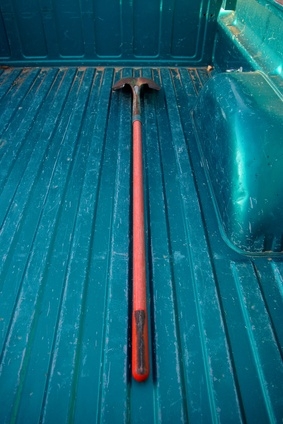
Many companies offer after-market options from custom gauges to high-cost rims, and the costs to customize can be steep. One option for customizing trucks is to add a tonneau cover. A tonneau cover sits on top of your truck bed and protects it from weather, streamlines your truck, and creates a sealed storage area. Tonneau covers can be expensive to purchase but simple to build. The project below outlines a tonneau cover for a '69 Ford F100 standard-size bed. Dimensions can be altered according to the size of your truck.
Measure width, height and depth of the factory holes on the rails of the bed. These are the measurements for stability beams. Measure the length of the bed from the front edge to the top of the tailgate and the width of the bed from the outer edge of the holes of one side to the outer edge of the holes on the other side. These are the measurements for the tonneau cover. The project truck dimensions are 70-by-99 inches, width by length, and 1 5/8 inches by 2 3/16 inches, width and length of the factory holes.
Cut a frame for the tonneau cover. Cut two strips to the width of the cover using a circular saw. Cut two strips to the length of the cover minus 8 inches. Cut two additional strips to the width of your cover minus 8 inches. For the project, this would be two strips of 1-by-4-inch pine board to 70 inches, two strips to 91 inches and two additional strips to 62 inches.
Cut the sheet of 1/4-inch plywood to the width of the cover and length of the cover. You may have to use two sheets of plywood to make the width and length. For stability, use equal sizes of each panel used. For the project vehicle, the width is 70 inches and the length is 99 inches, so two sheets will be needed. Cut both sheets to 70-by-45 1/2 inches. This will allow the sheets to be equal in size and maintain stability.
Assemble the frame and join the pieces together using corner braces. Position the two full 70-inch boards top and bottom with the two 91-inch strips on each side. Position the two 62-inch beams evenly spaced at 31 inches from the base beam and 31 inches from the top beam in the center. Secure at each junction using corner braces and 1/2-inch wood screws. Do not put any braces on the outside of the frame as this will be an exposed area and will make sanding and painting difficult.
Brush wood glue over the surface of the frame and lay the plywood on top of the frame. Secure the plywood to the frame using 1/2-inch wood screws. Make sure the screw heads are either flush with the top of the plywood board or slightly sunken. For additional security and stability, space the screws approximately 1 foot apart while following the frame and use three screws in a triangle pattern spaced about 2 inches apart for each corner.
Place the cover onto the bed of your truck exactly as if it were complete and in place. Trace onto the cover where the bed contacts the cover. This can be done easily by climbing into the bed and tracing the contour of the bed onto the cover.
Cut four strips of 2-by-2-inch wood to 2 feet in length to be secured to the frame along the traced lines. This will hold the tonneau cover in place on the bed so that it does not slide around. When attached to the frame, they need to be flush with the inside edge of the traced line. Screw these in place, centered on each side, using four 3-inch wood screws.
You have two options for additional security. You can cut four to six stability beams using the measurements from step one. For the project vehicle, four were used cut 1 5/8-by-2 3/16 inches by 4 feet in depth out of 2-by-4-inch boards and secured to the frame with 3-inch wood screws. If you want a tonneau cover that raises, you can attach industrial hinges to the bed and cover to secure the cover and two support lifts (one on each side of the bed) to assist with raising the cover. Use either the stability beams or hinge options; otherwise, the cover could easily blow off while driving.
Sand and paint the cover. The only metal aspect to the cover visible should be screw heads visible on the top which can be covered with wood putty and sanded. Sanding the edges of the cover to make it smooth or curved and using wood putty to fill any gaps will streamline the appearance and make it look like a professionally made cover. Paint the wood with an all-weather primer and paint to your standards. Once painted, clear coat can be added to give it a similar shine as your vehicle.